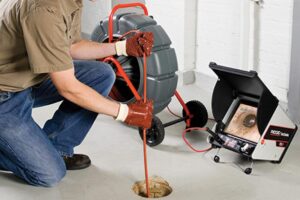▷7 Safety Measures for Conducting Sewer Camera Video Inspections In San Diego
7 Safety Measures for Conducting Sewer Camera Video Inspections In San Diego
Did you know that approximately 85% of sewer line issues go unnoticed until they become major problems? Conducting regular sewer camera video inspections can save you from costly repairs and headaches down the line. By following these five expert tips, you can efficiently navigate through the process and ensure your sewer system is in top-notch condition. Stay ahead of potential disasters with our comprehensive guide.
Understanding Sewer Inspection Cameras
Basics of Drain Cameras
Sewer inspection cameras are small, waterproof devices equipped with high-resolution cameras used to inspect sewer pipes. They come in various sizes to fit different pipe diameters. These cameras are attached to flexible rods, allowing them to navigate through the twists and turns of sewer lines. The images captured by these cameras are displayed on a monitor above the ground, enabling inspectors to identify any issues accurately.
- Various sizes available
- Equipped with high-resolution cameras
- Images displayed on a monitor for easy identification
Video Inspection Process
During a sewer camera video inspection, the camera is inserted into the sewer line through an access point such as a cleanout or vent. As the camera travels through the pipe, it records real-time video footage, transmitting it to the monitor for immediate viewing. Inspectors can assess the condition of the pipes, identify blockages, leaks, cracks, root intrusions, and other issues that may be affecting the sewer system’s functionality.
- Camera inserted through access point
- Real-time video footage recorded
- Immediate viewing on monitor
Detectable Pipe Issues
Sewer inspection cameras can detect various pipe issues such as blockages caused by debris buildup or tree roots invading the pipes. They can also identify cracks, leaks, offset joints, and corrosion within the sewer lines. By pinpointing these problems accurately, inspectors can recommend appropriate solutions to address them promptly.
- Blockages from debris or tree roots
- Cracks, leaks, offset joints identified
- Corrosion within sewer lines detected
Preparing for the Inspection
Safety Measures
Ensure safety during sewer camera inspections by wearing protective gear such as gloves, goggles, and masks. Prioritize adequate ventilation in confined spaces to prevent exposure to harmful fumes.
Inspectors should also be cautious of electrical hazards and slippery surfaces within sewer systems. Avoiding direct contact with sewage is crucial to prevent contamination and health risks.
Equipment Check
Before starting the inspection, thoroughly examine the sewer camera equipment for any signs of damage or malfunction. Check the camera lens, cables, monitor, and recording device for optimal functionality.
Make sure all components are properly connected and calibrated to capture clear images and videos during the inspection process. A well-maintained camera system enhances the accuracy of detecting sewer line issues.
Setting Expectations
Communicate with clients about the inspection procedure, explaining how the sewer camera works and what they can expect during the process. Manage expectations regarding potential findings like blockages, leaks, or structural damage within the sewer lines.
Educate clients on the importance of regular sewer inspections for preventive maintenance and early detection of problems. Providing clear information helps build trust and ensures a smooth inspection experience for both parties.
Conducting the Inspection
Avoid Forceful Pushing
When operating the sewer camera, avoid forceful pushing to prevent damage to the equipment or potential blockages. Gentle movements are key.
Steer Clear of Fast Motions
Avoid fast motions while maneuvering the camera through the sewer lines as it can lead to blurry or distorted video footage.
Liquid Immersion Precautions
Take precautions to prevent liquid immersion of the camera system, ensuring its durability and functionality. Keep it dry and secure during inspections.
Heat Exposure Prevention
To maintain the longevity of the equipment, prevent heat exposure by avoiding placing the camera in high-temperature environments for extended periods.
Identifying Common Issues
Broken or Cracked Pipes
When inspecting sewer lines, identifying broken or cracked pipes is crucial. These issues can lead to leaks and sewage backups. Look for misaligned sections and corrosion signs.
Sagging Sewer Lines
Sagging sewer lines can cause blockages and poor drainage. Use the camera to check for low points in the pipe where waste may accumulate.
Blockage Indicators
Detecting blockages indicators such as grease buildup, debris accumulation, and sediment deposits is vital. These can lead to clogs and sewer line obstructions.
Tree Roots Detection
Identify tree roots intrusion as they can damage sewer pipes over time. Look for root masses, cracks caused by roots, and signs of pipe displacement.
After the Inspection
Analyzing Video Data
Upon completing the sewer camera video inspection, it is crucial to analyze the recorded data thoroughly. Look for key issues such as cracks, blockages, root intrusions, or pipe misalignments. Utilize this information to determine the severity of each problem and prioritize repairs.
When analyzing the video data, note down specific locations within the sewer system where issues are detected. This detailed documentation will aid in creating an effective repair plan. Consider seeking input from experienced professionals to ensure accurate interpretation of the findings.
Deciding on Repair Methods
After identifying and analyzing the issues through the video inspection, it’s time to decide on suitable repair methods. Based on the severity and location of each problem, choose appropriate solutions such as spot repairs, lining, or complete pipe replacement. Consider factors like cost-effectiveness and long-term durability when making repair decisions.
When deciding on repair methods, weigh the pros and cons of each option carefully. Seek advice from qualified contractors to determine the most efficient and lasting solutions for your sewer system.
Planning Follow-Up Inspections
To maintain the health and functionality of your sewer system, plan follow-up inspections regularly. Establish a schedule based on the initial findings and recommendations from professionals. Regular inspections help in detecting new issues early, preventing costly repairs in the future.
Create a maintenance plan that includes periodic sewer camera video inspections to ensure ongoing monitoring of your system’s condition. By staying proactive with follow-up inspections, you can address any emerging problems promptly and maintain optimal performance.
FAQs
How Do Sewer Inspection Cameras Work?
Sewer inspection cameras are inserted into the sewer line to capture real-time video footage. The camera transmits images to a monitor, allowing professionals to identify any issues such as blockages or cracks without digging up the pipes.
What Are The Benefits Of Conducting A Sewer Camera Video Inspection?
Sewer camera inspections help in identifying problems accurately, reducing the need for invasive digging, saving time and money. They also provide visual evidence of the sewer line’s condition, aiding in making informed decisions about necessary repairs or maintenance.
How Should One Prepare For A Sewer Camera Video Inspection?
Before the inspection, ensure that the sewer line is accessible by clearing any obstructions. Inform all occupants about the inspection timing and secure pets. It’s advisable to have a professional plumbing team on standby for immediate action based on the findings.
What Common Issues Can Be Identified Through A Sewer Camera Video Inspection?
Common issues detected during inspections include tree root intrusion, pipe corrosion, blockages from debris buildup, cracks or breaks in the pipes, and misaligned joints. Identifying these problems early can prevent costly repairs and potential health hazards.
Are There Any Post-Inspection Measures Recommended After A Sewer Camera Video Inspection?
After the inspection, review the findings with the plumbing professionals to discuss repair options if issues are detected. Maintain a record of the inspection report for future reference and schedule regular follow-up inspections to ensure ongoing sewer system health and functionality.
Conclusion
In conclusion, by following the five tips outlined in this guide, you can conduct sewer camera video inspections like a pro. Understanding the equipment, preparing adequately, executing the inspection diligently, identifying potential issues, and post-inspection actions are crucial steps to ensure a thorough and effective assessment of your sewer system. By implementing these practices, you not only save time and money but also gain valuable insights into the condition of your pipes.
Take charge of your sewer maintenance today by applying these expert tips. Regular inspections can prevent costly repairs down the line and help you maintain a healthy sewer system. Remember, a little effort now can go a long way in preserving the integrity of your property’s plumbing infrastructure. Stay proactive and keep your sewers in top shape!
Give Home Pro Plumbing a call right away to learn more about how our experts can help with leak detection in San Diego, CA.
Our Plumbing & Leak Detection Services
Related Posts

▷5 Benefits of Hydro Jet Plumbing: A Comprehensive Guide In San Diego
5 Benefits of Hydro Jet Plumbing: A Comprehensive Guide In San Diego Hydrojet plumbing is a…

▷Essential Tips for Installing a Heat Pump Water Heater In San Diego
Essential Tips for Installing a Heat Pump Water Heater In San Diego Did you know…

